The Structure of the Heart
Heart structure
- The heart has two sides:
- The left side pumps oxygenated blood around the body in the systemic circulation
- The right side pumps deoxygenated blood to the lungs in the pulmonary circulation
- The left and right sides of the heart are separated by a wall of muscular tissue called the septum.
- The septum is very important for ensuring blood doesn’t mix between the left and right sides of the heart
- The heart is divided into four chambers
- The two top chambers are atria (singular atrium) - they receive blood from the veins and pump it through to the ventricles
- The bottom two chambers are ventricles - they receive blood from the atria and pump it out into the arteries
- Valves are important for keeping blood flowing forward in the right direction and stopping it flowing backwards. They are also important for maintaining the correct pressure in the chambers of the heart
- The atria and ventricles are separated by the atrioventricular valves
- The right atrium and ventricle are separated by the tricuspid valve
- The left atrium and ventricle are separated by the bicuspid valve
- The ventricles and the arteries that leave the heart are separated by semi-lunar valves
- The right ventricle and the pulmonary artery are separated by the pulmonary valve
- The left ventricle and aorta are separated by the aortic valve
- The atria and ventricles are separated by the atrioventricular valves
- There are two blood vessels bringing blood into the heart; the vena cava and pulmonary vein
- There are two blood vessels taking blood out of the heart; the pulmonary artery and aorta
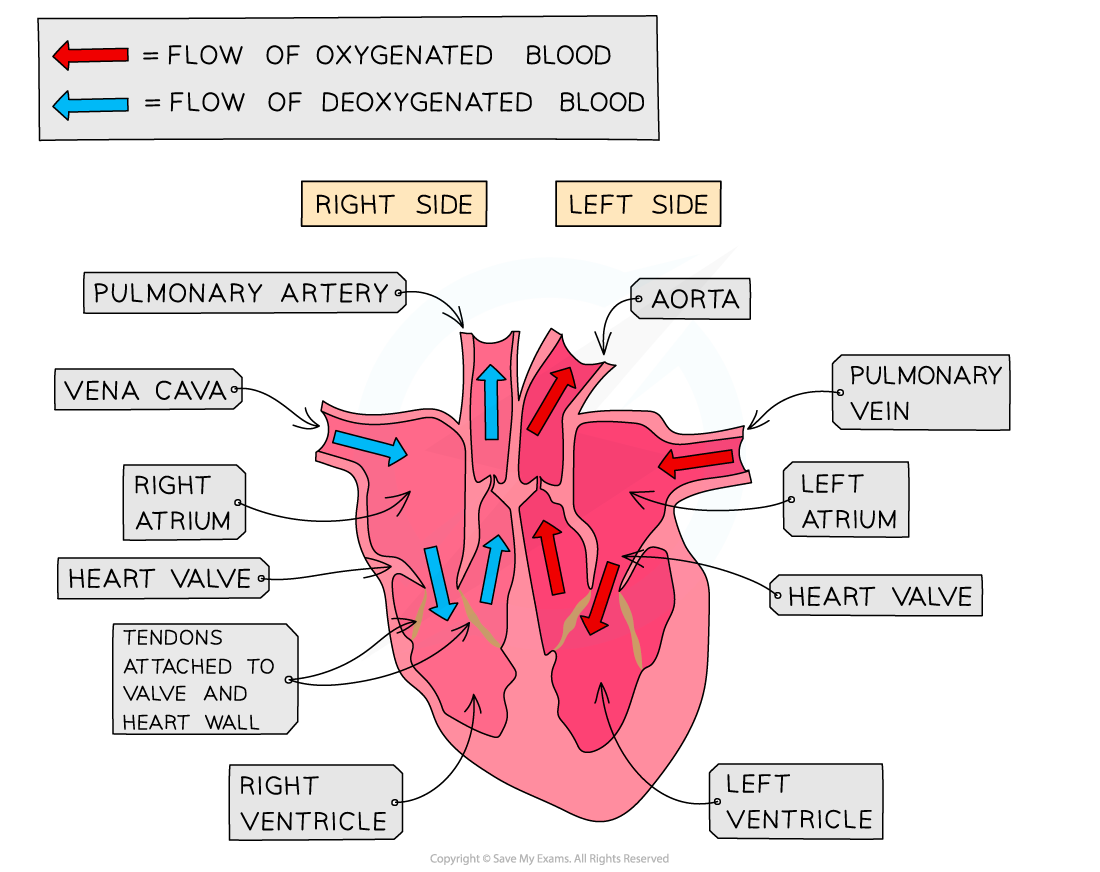
The human heart has four chambers and is separated into two halves by the septum
The pathway of blood through the heart
- Deoxygenated blood coming from the body flows through the vena cava and into the right atrium
- The atrium contracts and the blood is forced through the atrioventricular (tricuspid) valve into the right ventricle
- The ventricle contracts and the blood is pushed through the semilunar valve into the pulmonary artery
- The blood travels to the lungs and moves through the capillaries past the alveoli where gas exchange takes place
- Low pressure blood flow on this side of the heart prevents damage to the capillaries in the lungs
- Oxygenated blood returns via the pulmonary vein to the left atrium
- The atrium contracts and forces the blood through the atrioventricular (bicuspid) valve into the left ventricle
- The ventricle contracts and the blood is forced through the semilunar valve and out through the aorta
- Thicker muscle walls of the left ventricle produce a high enough pressure for the blood to travel around the whole body
Coronary arteries
- The heart is a muscle and so requires its own blood supply to enable its cells to carry out aerobic respiration
- The heart receives blood through arteries on its surface called coronary arteries
- It’s important that these arteries remain clear of blockages called plaques, as this could lead to angina or a heart attack (myocardial infarction)
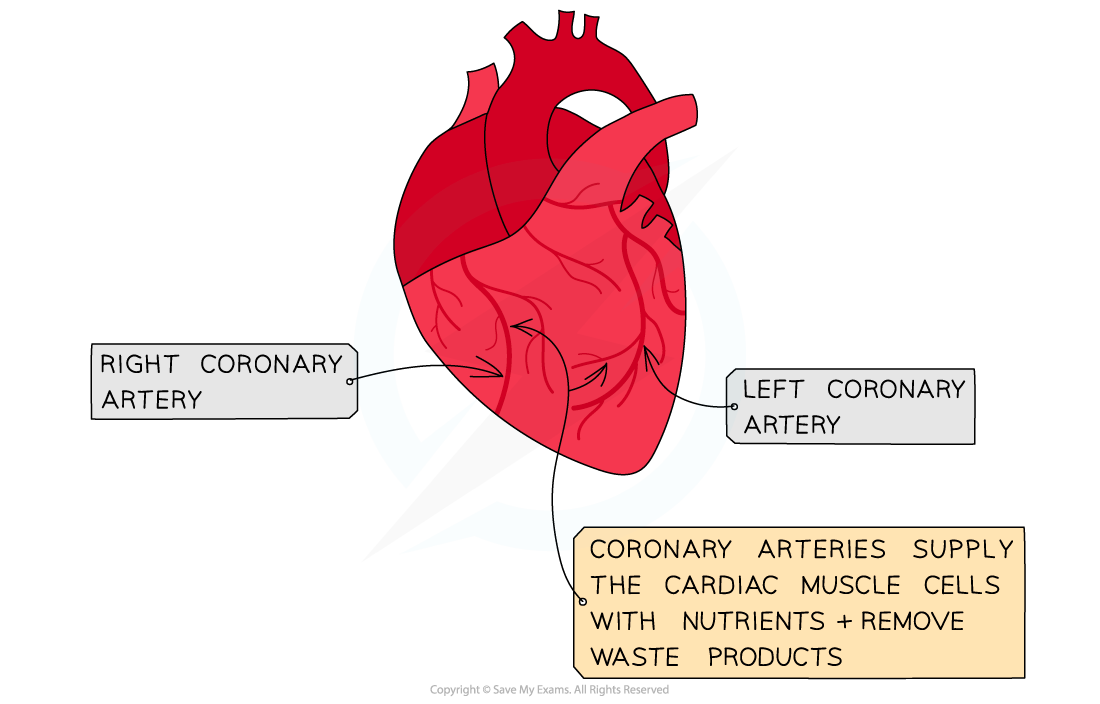
The coronary arteries cover the outside of the heart, supplying it with oxygenated blood
Dissection of a mammalian heart
- Dissections are a vital part of scientific research
- They allow for the internal structures of organs to be examined so that theories can be made about how they function
Apparatus
- Scissors
- Scalpel
- Tweezers / Forceps
- Dissection board
- Paper towels
- Biological specimen
- Pins
- Gloves
- Goggles
Method
- A lab coat, gloves and eye protection should be worn
- This is done to avoid contamination with biological material which could cause an allergic reaction or contain harmful microorganisms
- Place the specimen on the dissecting board
- Use the tools to access the desired structure
- When using the scalpel cut away from your body and keep your fingers far from the blade to reduce the chance of cutting yourself
- Scissors can be used for cutting large sections of tissue (cuts do not need to be precise)
- Scalpel enables finer, more precise cutting and needs to be sharp to ensure this
- Use pins to move the other sections of the specimen aside to leave the desired structure exposed
Identifying structures during the dissection
- Observe the outside of the heart to identify the coronary arteries supplying the cardiac muscle with a oxygenated blood and nutrients
- The coronary arteries branch off the aorta near to the semilunar valves
- The coronary arteries are often surrounded by white, fatty tissue
- Position the heart and study it from the top, you should be able to identify
- Arteries leaving the heart - these can be identified by the thicker walls
- Poke a glass rod through the aorta to feel the thicker walls of the left ventricle and through the pulmonary artery to feel the thinner walls of the right ventricle
- Veins entering the heart - these can be identified by their thinner walls
- Poking a glass rod through the pulmonary vein will lead to the left atrium and poking a glass rod through the superior or inferior vena cava will lead to the right atrium.
- Arteries leaving the heart - these can be identified by the thicker walls
- Lay the heart down on its flatter side, this is the dorsal side.
- Dorsal refers to the back of an organism
- The ventral side is now closest to you with the pulmonary artery facing outwards and in front of the aorta
- Ventral refers to the front of an organism
- Make an incision from the Aorta, underneath the pulmonary artery and around the apex of the heart to cut the heart into halves
- This should open up the heart to show the ventricles so that you can compare the thickness of the walls
- The atrioventricular valves should also be visible as a white flap of connective tissue attached by tendinous cords which prevent inversion of the valve
- The tendinous cords are stringy in appearance and are sometimes referred to as the heartstrings
- The atria are wrinkled in appearance and can be tricky to see compared with the ventricles.
- They sit just above the atrioventricular valves and are the entry point for the veins (the pulmonary vein and the vena cava)
- They are significantly smaller than the ventricles
- It is possible that the atria and blood vessels may be sliced off some specimens
- Observe the septum of the heart which separates the left and right-hand sides. The septum contains the conductive fibres which stimulate contraction, however, these are not visible to the eye
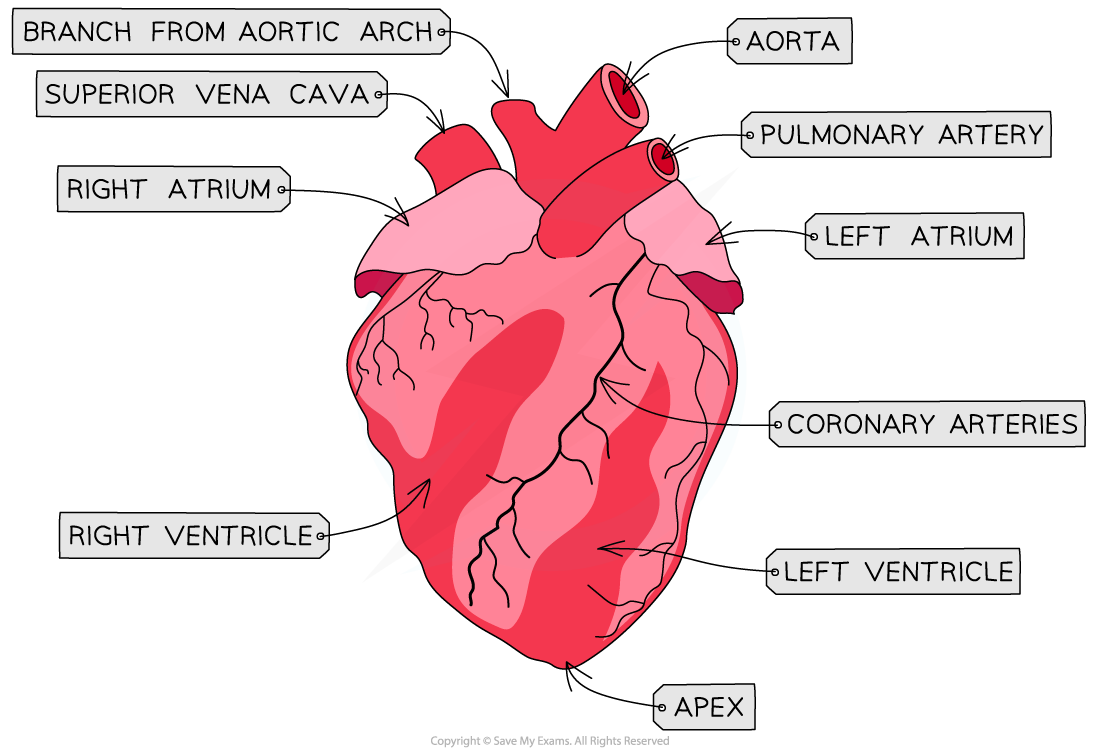
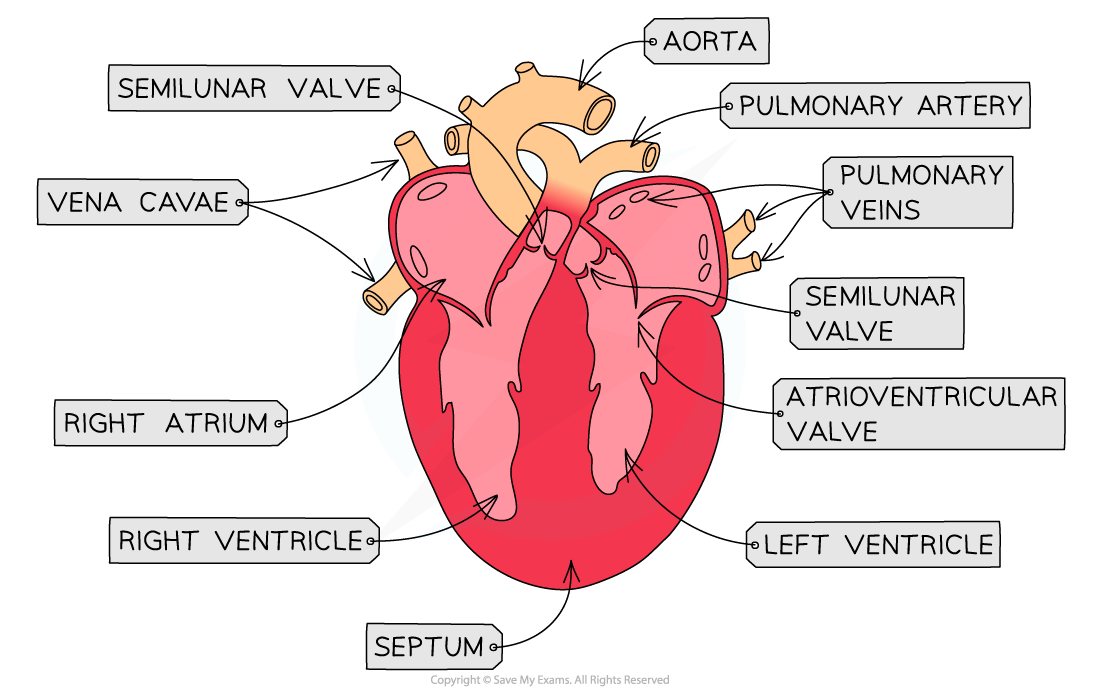
Following a careful method during a heart dissection will allow you to identify the different structures
Exam Tip
Remember:
- Arteries carry blood away from the heart
- Veins carry blood into the heart
When explaining the route through the heart we usually describe it as one continuous pathway with only one atrium or ventricle being discussed at a time, but remember that in reality, both atria contract at the same time and both ventricles contract at the same time
Also, the heart is labelled as if it was in the chest so the left side of a diagram is actually the right hand side and vice versa
Atherosclerosis
- Occlusion can be defined as
- The narrowing of the arteries due to a blockage
- The arteries can be blocked by the process of atherosclerosis
- Atherosclerosis results in a build-up of layers of fatty material known as plaque inside arteries
- The main cause of atheroma development is the presence of low-density lipoprotein (LDL) which forms from saturated fats and cholesterol
- LDL builds up in regions of the arteries and phagocytes move to these areas, engulfing the LDL by endocytosis
- The enlarged phagocyte cells are then covered by smooth muscle cells which cause a bulging of the endothelium in the artery
- Deposition of calcium ions can worsen the situation by hardening the endothelium
- This narrows the lumen of the artery, reducing the space for blood flow
Consequences of occlusion of the arteries
- When an atheroma builds up enough to cause impeded blood flow, tissues do not receive the required level of oxygen and nutrients
- This can inhibit cell functions
- Occlusion of the coronary arteries in particular can lead to significant health issues such as coronary heart disease
- The flow of blood through the coronary arteries is reduced, resulting in a lack of oxygen and nutrients for the heart muscle
- Partial blockage of the coronary arteries creates a restricted blood flow to the cardiac muscle cells and results in severe chest pains called angina as the heart muscle beats faster to try to increase blood supply
- Complete blockage means cells in the area of the heart not receiving blood will not be able to respire aerobically; these cells will be unable to contract, leading to a heart attack
- Atheromas can sometimes rupture, leading to the development of a blood clot
- Blood clots can worsen existing blockages, or break off and travel into smaller blood vessels
- Blood clots that travel to the coronary arteries can cause a heart attack
- Blood clots that travel to the brain can lead to a stroke
- Blood clots can worsen existing blockages, or break off and travel into smaller blood vessels
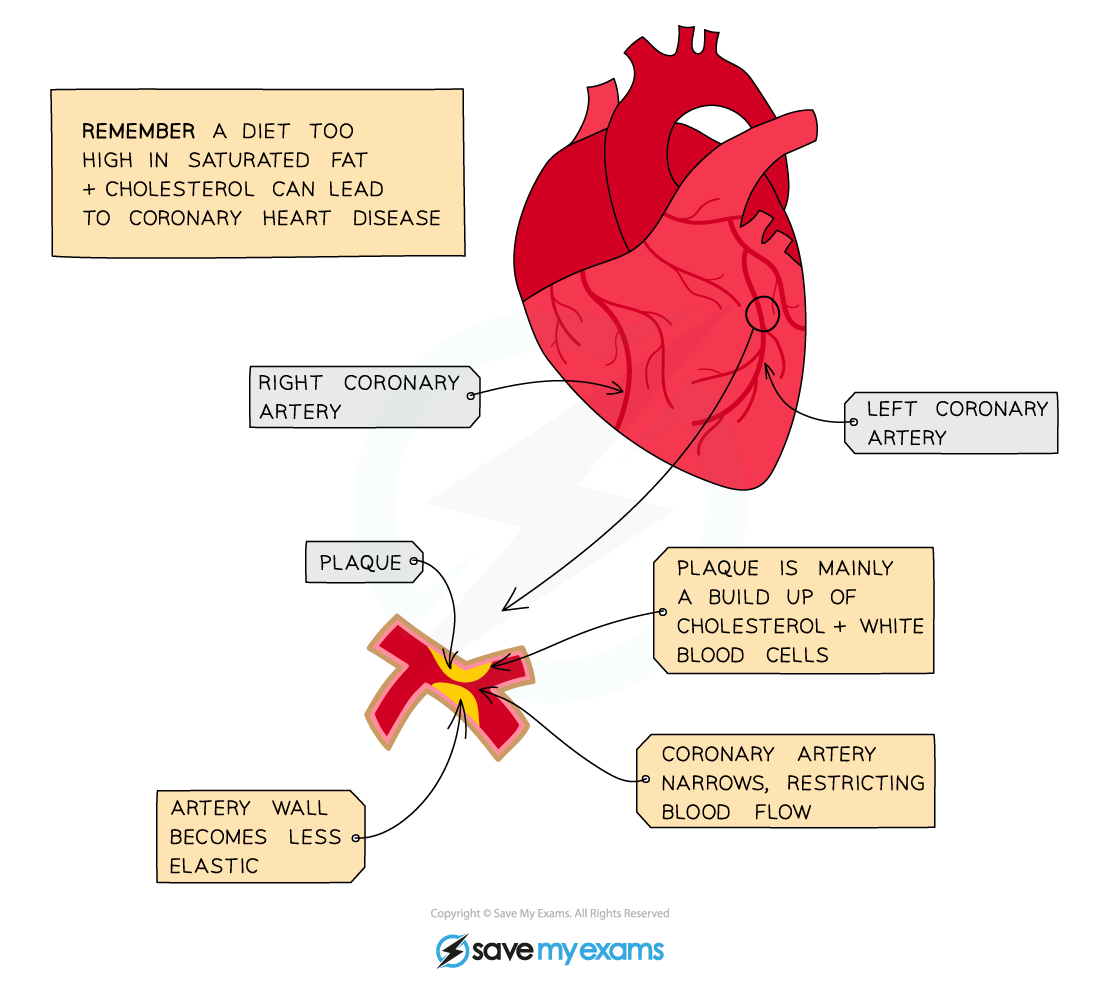
Buildup of plaque in the coronary arteries narrows the lumen
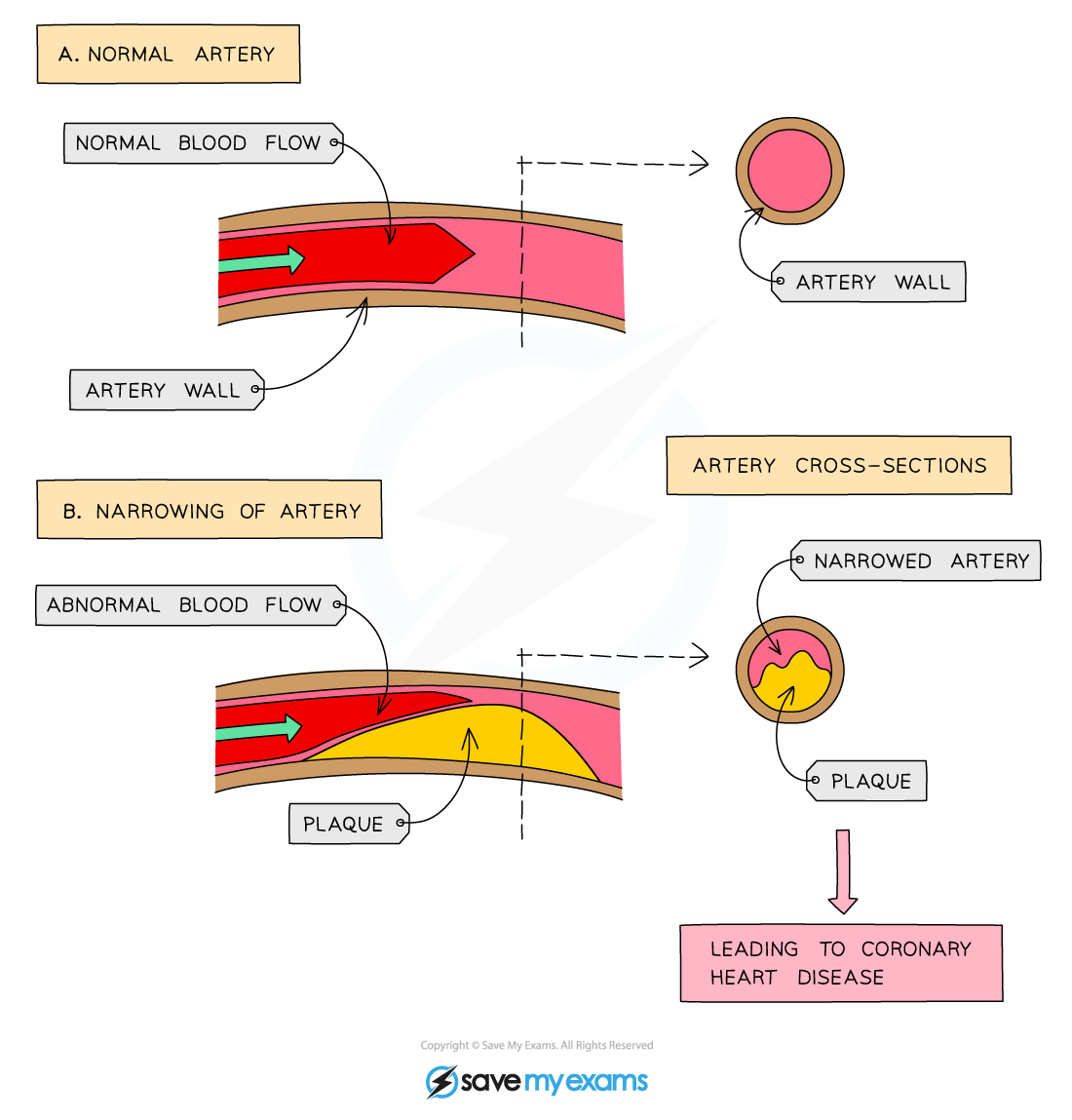
The effect of a narrowed lumen in a coronary artery is reduced blood flow to the heart
Risk factors for atherosclerosis
- There are several risk factors which will increase the chances of coronary heart disease:
- Consumption of trans-fats
- These damage the endothelium of the artery initiating formation of an atheroma
- Constant high blood sugar
- This is usually the result of consumption of foods high in carbohydrate
- High blood pressure
- This increases the force of the blood against the artery walls and consequently leads to damage of the vessels
- Blood pressure can increase due to smoking or stress
- High blood concentrations of LDL
- Speeds up the build up of fatty plaques in the arteries, leading to blockages
- Smoking
- Chemicals in smoke cause an increase in plaque build up and an increase in blood pressure
- Carbon monoxide also reduces the oxygen carrying capacity of the red blood cells
- Infection by certain microbes
- Chlamydia pneumoniae can infect the arterial wall and trigger inflammation which promotes atherosclerosis
- Microbes of the small intestine produce the chemical trimethylamine N-oxide which promotes atherosclerosis
- Consumption of trans-fats
Structure of the Blood Vessels
- The body contains several different types of blood vessel
- The walls of each type of blood vessel have a structure that relates to the function of the vessel
- Arteries transport blood away from the heart (usually at high pressure). They are structured as follows:
- Three thick layers in their walls
- A high proportion of muscle and elastic fibres
- Narrow lumen
- No valves
- Capillaries transport blood from arteries to veins, and are located between the cells in the tissues. They are structured as follows:
- Walls are only one cell thick (endothelial layer only)
- No muscle or elastic fibres
- No valves
- Arteries transport blood away from the heart (usually at high pressure). They are structured as follows:
- Veins transport blood into the heart (usually at low pressure). They are structured as follows:
- Thin walls with three layers
- Low proportion of muscle and elastic fibres compared to arteries
- Large lumen
- Valves (usually) present
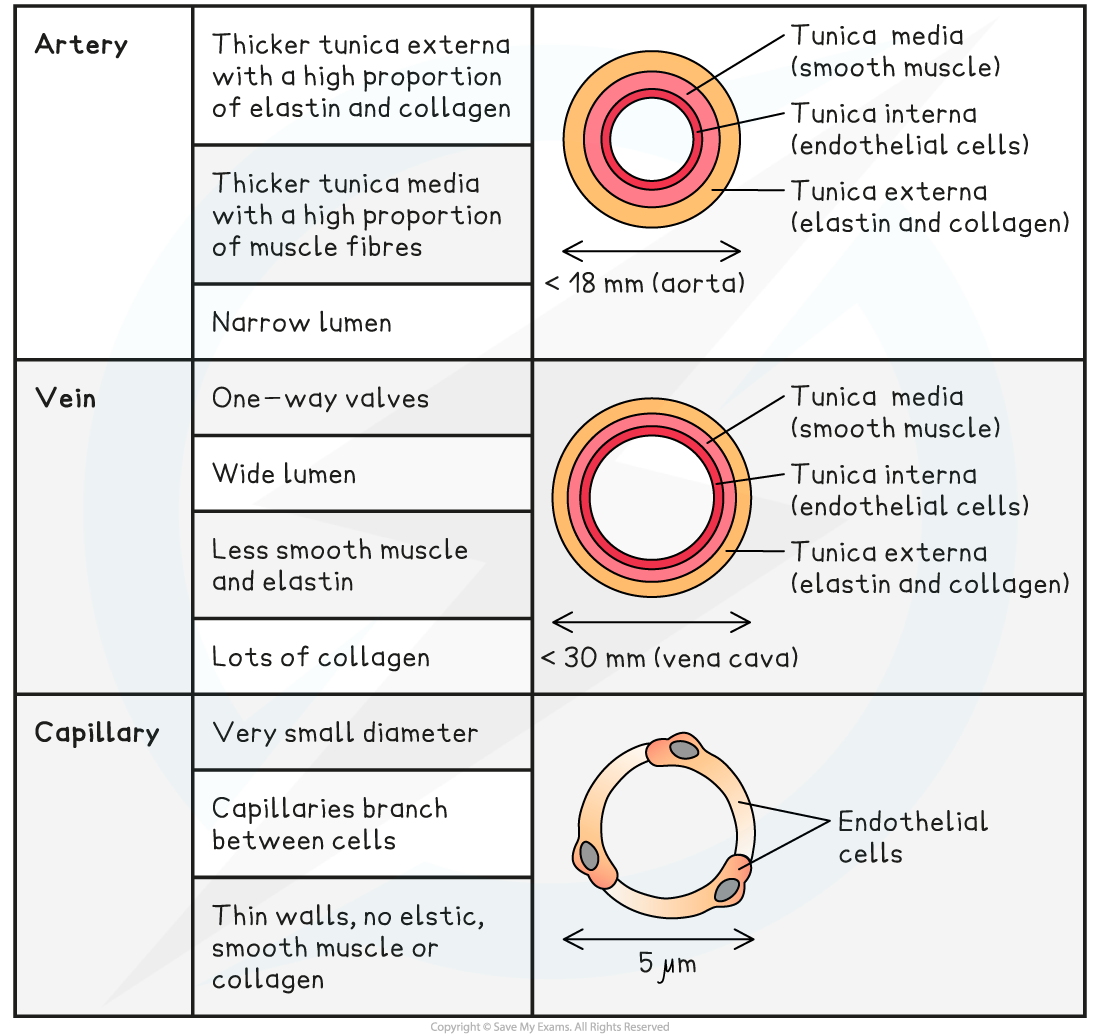
The three main categories of blood vessel can be identified by comparing their structures
Exam Tip
For “explain” questions relating to blood vessel structure, remember to pair a description of a structural feature to an explanation of exactly how it helps the blood vessel to function. For example “capillary walls are one-cell thick, which enables quick and efficient diffusion of substances such as oxygen and glucose to the cells”
